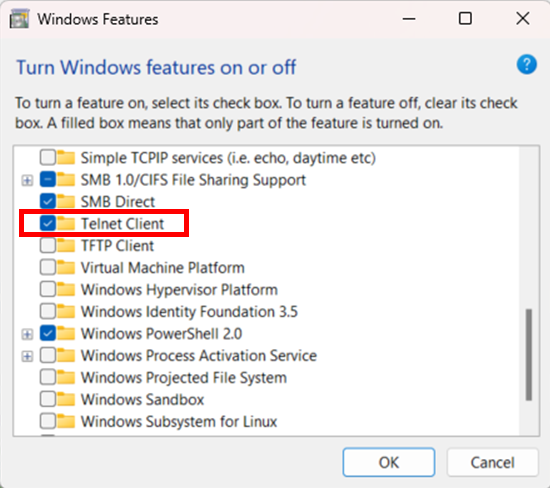Configuring Specific Ports for SpinFire and Actify Vendor Daemon
This Guide is how to configure SpinFire and actifyd.exe to use specific ports (static ports) and not automatic ports (dynamic ports). PortNumber specifies the TCP/IP port to use for communication with the license manager daemon.
A valid port number is any unused port number between 0 and 64000. If the TCP/IP port number is not specified, FLEXnet uses a port number in the range 27000 to 27009.
NOTE - Setting a specified port for the Vendor Daemon (actifyd.exe) and the lmgrd.exe is not needed in most cases. But with some "firewall" configurations and/or VPN configurations this can be required . Steps for adding actifyd.exe + lmgrd.exe to the firewall can be found here.
1.Set a Specified Port for SpinFire
- Edit the sfpflv2.DAT to use 27500 port as shown below. Skip Step 2 if you do not need to define the Actify Vendor Daemon Port.

- Now copy the edited sfpflv2.dat (if you have not already) to your Floating License Manager folder or the location it is currently reading the sfpflv2.dat from.

2. Setting up Specified Port for ActifyD.exe Vendor Daemon.
In order to set the license manager to interface with the vendor daemon over a predefined static TCP-port port number (by default the port number is dynamic), add the number in the end of the VENDOR line in the license file (sfpflv2.dat) on the license server machine, in the following format e.g.:
VENDOR actifyd port=<VendorPortNumber>
For example:
VENDOR actifyd port=52500
The vendor daemon is now static-locked to the specified TCP-port 52500. Proceed to Step 3 for this change to take effect.
3. Reread the SFPFLV2.DAT in the Floating License Manager for the changes to take effect
3. Stop, Start and Re-read the sfpflv2.dat file, you will see a success or error message along the bottom. After the confirmation that the sfpflv2.dat has been successfully loaded into the Floatng License Manager proceed to the next step.
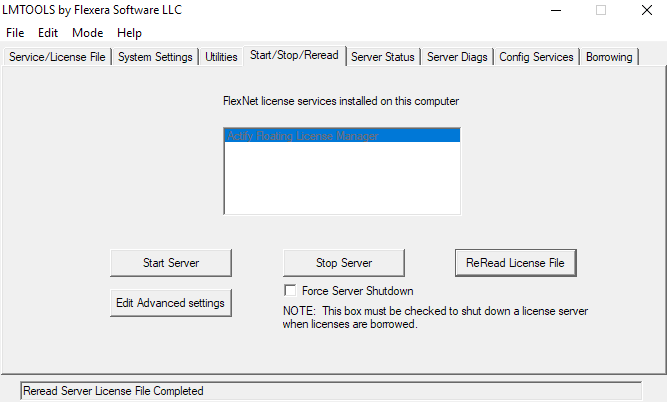
4. SpinFire End User Activation
There are two methods for Floating License Manager users to activate their SpinFire. the first is to go to their Options > Activation page and enter the server details (Server Name, MAC(Physical) Address and the now specified port for SpinFire as shown below. In the first instance they should test the connection works and then to do "Activate Floating License", a window will pop to say it has been successful or not.


The second method is to copy the license.al and sfpflv2.dat files to the end users license folder, both files must contain the specified SpinFire port and the Vendor Daemon port if that as also done on the server. The next time the user opens SpinFire Ultimate the license will be activated.

The License.al on the SpinFire users machines should look something like this, with the SpinFire and/or Vendor Daemon port defined
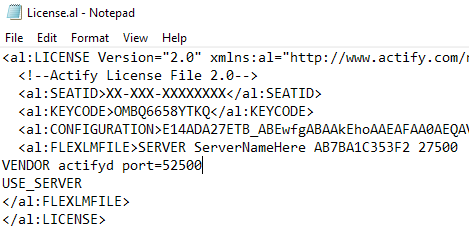
Listed below are some guidelines to follow when it comes to SpinFire/Floating License Manager configurations:
- If a port for SpinFire has been specified on the Floating License Manager, all SpinFire Clients must be using the same port or they will be unable to activate. They must specify the port in the "Activate Floating License" as well as the other server details.
- If Activate Floating License is not successful, copy the two license files (License.al and sfpflv2.dat) to the Spinfire license folders on the end user machines.
- If their license folder is empty after trying to do Activate Floating License, it may be that there is insufficient permissions on the license folder.
- When the Floating License Manager has been updated with a new SFPFLV2.dat file that has a new End of Maintenance date, the end users must also update. Normally by Activate Floating License, they will of course need to know the server details AND the specified port in the SFPFLV2.DAT file otherwise they will be unable to activate.
- When a specified port is being used for SpinFire or ActifyD.exe , it is your Network Administrator's responsbility to ensure that no other products on that Server is using the port to avoid problems later.
- Please note that the latest Floating License Manager is mandatory to use SpinFire Ultimate 11.7.0 release!.
- If you are using a Floating License Manager supplied from somewhere else the following must be true to be compatible with SpinFire Ultimate:
- Must be 64 bit version of the Floating License Manager
- lmgrd.exe version must fit to our version # = or > to ours
- lmtools.exe version must be related to lmgrd.exe version
- actifyd.exe will be used from the folder of the related lmgrd.exe used and setup by lmtools.exe
5. If there are issues after following this page's steps, please provide the following to Actify Support:
Provide a copy of the SpinFire.log from one or more machines suffering the Floating License issue:

2. Provide a copy of the debug.log from the Floating License Manager folder. If one does not exist in the FLM folder, Create a .txt file and name it debug.log (with the .log extension) and save, then go to the LMTOOLS > Config Services and add the path to this file. You may need to stop and start the Service to get an output of information to the debug.log if it is empty.

3. Ensure the relevant Service is currently running and is pointing to the correct files (LMGRD.exe, sfpflv2.dat and the debug.log and is ticked along the bottom as shown in the screenshot below.
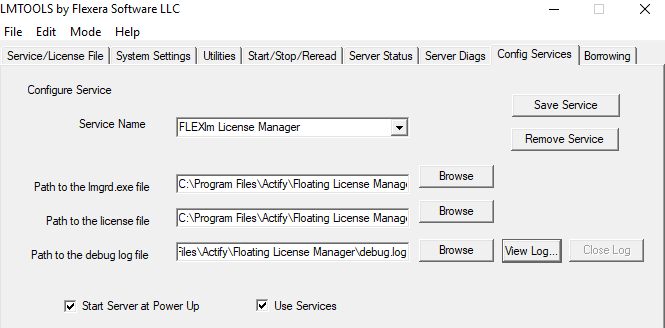
4. Click Perform Status Enquiry on the Server Status page and copy the output to an email or file to share with Actify. Repeat the same for the Perform Diagnostics on the Server Diags page.
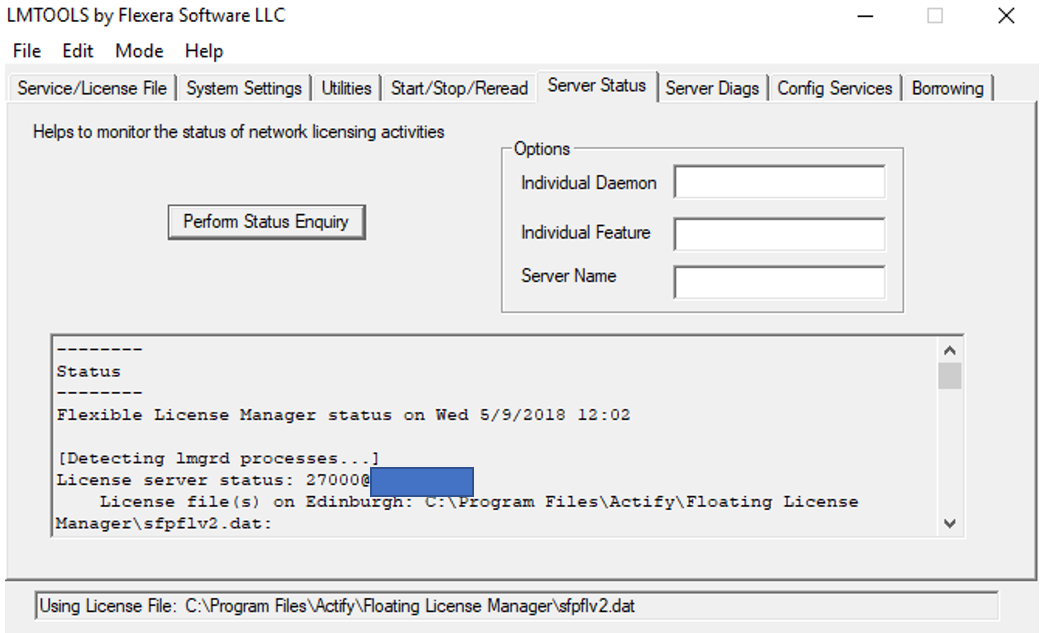
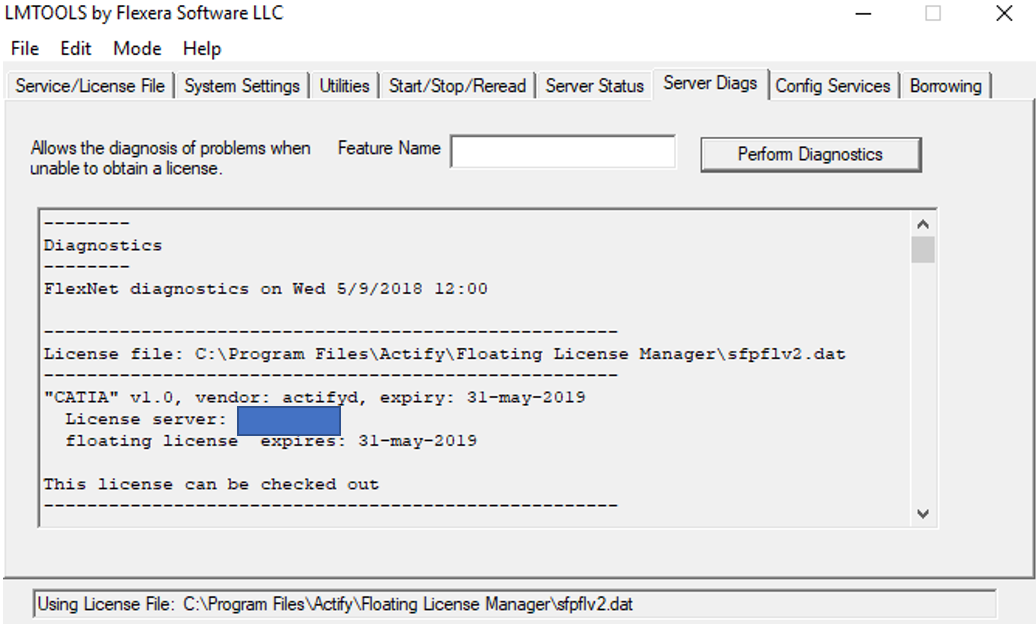
5. Can one of the effected SpinFire End Users Telnet the server? (e.g.: telnet <yourserver> 27500 through command prompt)

*Note: To use Telnet on a Windows OS, Telnet Client must first be enabled under Windows Features.
